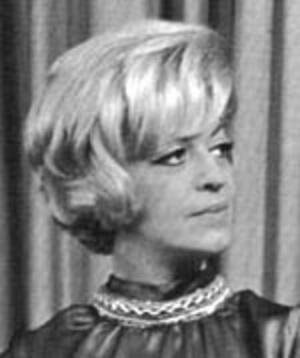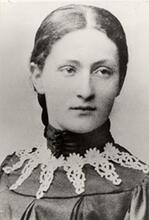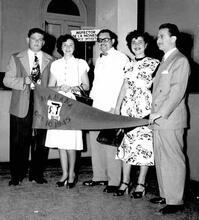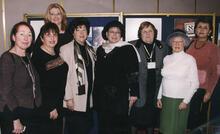Brazil, Contemporary
The Brazilian Jewish community is the second largest in South America and one of the ten largest in the world. Jewish women’s societies played important roles in facilitating the absorption of Jewish immigrants from Europe, the Middle East, and North Africa. Because of the considerable cultural differences amid waves of immigration from distinct origins, a multiplicity of women’s societies each cared for its own compatriots. Women also participated in the internal polemics of Jewish life nurtured by the political and ideological currents dividing the immigrants, especially Zionism and leftist activism. Since the nineteenth century, Jewish women have also made important contributions to Brazilian cultural, artistic, and intellectual life.
The Brazilian Jewish Community
The Brazilian Jewish community is the second largest in South America and one of the ten largest in the world. In 2020, the estimated population was around 120,000. The history of Jewish immigration and life in Brazil may be divided into two major periods: the colonial, from 1500 to 1808, and the independent period, from 1808 to the present.
The presence of New Christians (Jews who had been forcibly converted to Catholicism in Spain and Portugal) in the territory dates from 1500 and the existence of the esnogas (the space used by the New Christians to assemble and pray) is mentioned in the testimonies, denunciations, and confessions collected by both the First Visitation (1591–1595) and the Second Visitation (1618–1619) of the Holy Inquisition. The martyrology of a large number of New Christian women, including Branca Dias (c. 1515–c. 1588), whose descendants were also victims of the Inquisition, serves as testimony to their role in maintaining Judaism.
Due to the oppressive presence of the Inquisition under Portuguese rule, Jews were only able to enjoy a tolerant regime and to establish their communities during the short period of Dutch rule in the northeast coastal areas of the country (1624–1654). There is evidence that the communities later known as Zur Israel and Maguen Abraham were already organized by 1637.
After the military defeat of the Dutch armies by the Portuguese in 1654 and the resulting destruction of the Jewish communities in that region, the Inquisition accelerated its activities throughout the eighteenth century. Many Brazilians were sent to the auto da fé (the ceremony that preceded the sentence of execution), which was abolished only in 1794. In 1810, two years after the arrival in Brazil of the Portuguese royal family, Portugal signed a treaty of trade and navigation with England, which stipulated that foreigners living in Portuguese possessions would not be persecuted or harassed. From then on, new waves of Jewish immigration arrived in Brazil. The first of them, beginning between 1808 and 1822 and continuing throughout the nineteenth century, consisted of immigrants from North Africa, the so-called Moroccan Jews. These immigrants initially settled in the north of the country and began establishing small communities along the Amazon River, dealing with all sorts of merchandise that was exchanged for rubber, the main product of this vast area. Their first organized community, Shaar Hashamaim, was established in 1824 in the city of Belém, and the second, Essel Abraham, in 1889, along with elementary schools and self-help institutions.
In the first decades of the twentieth century these communities began to suffer not only because of the low demand for rubber but also because of the isolation caused by the vast distances between Jewish communities. As a result, Jews began moving towards the larger urban centers such as Rio de Janeiro and São Paulo in the south of the country. A wave of Alsatian immigrants followed, after the annexation by Germany of Alsace-Lorraine in the Franco-Prussian War of 1870-1871. The French Jews, who settled mainly in the major cities in the south of the country, brought with them Western European cosmopolitan culture, which attracted the Brazilian elite. Besides establishing fashion houses, stores for household equipment, and importation enterprises, they were very much engaged in the modernization of urban centers such as São Paulo and Rio de Janeiro and involved in the parceling and creation of neighborhoods, as well as the development of urban infrastructure facilities such as transportation or water and electricity systems.
Jews of European origin and their descendants, including most of North and South American Jewry.Ashkenazi immigration from Eastern Europe began in the last decades of the nineteenth century. In 1891 a large group fleeing the Tsarist Empire arrived in Brazil. During the first decades of the twentieth century, Ashkenazi immigration increased rapidly, constituting a majority that took a leadership role that endures to the present. As in Argentina, the Jewish Colonization Association (JCA) in 1904 initiated a colonization program in the state of Rio Grande do Sul, with the foundation of the Philippson settlement, followed in 1911–1912 by that of Quatro Irmãos. But the failure of the agricultural colonization promoted by JCA led many settlers to leave for urban centers where they joined the existing Jewish population. At the same time, in 1905, the government of the State of São Paulo promoted a program of agricultural colonization in the hinterland that also received Jews from Russia who settled in Nova Odessa and other colonies.
In the 1910s the Ashkenazi immigrants established organized communities in Rio de Janeiro, Porto Alegre, and São Paulo, creating models of community life to foster their social, cultural and religious needs, independent of the organizations established by the Moroccan and Alsatian immigrants of the previous century. However, this was a slow process, and although community associations sprang up as early as 1905, they were initially based on the landsmannschaften or groups defined by origin. A wider immigration wave from Eastern Europe took place between 1914 and 1933, resulting in an increase in the number of Jewish societies and institutions. Between 1933 and 1945 a large number of German Jews flocked to Brazil, where they organized their own independent societies. During the same period virulent anti-Jewish sentiment among government officials led to the adoption of a restrictive immigration policy with regard to what was called the “Semitic element.” Secret instructions were sent to the Brazilian diplomatic representatives abroad to discourage Jewish immigration precisely when the situation of European Jews became desperate. At such a crucial moment, when Jewish survival became a world problem and the fate of those who wanted to emigrate from Europe was discussed at the 1938 Evian Conference, Brazil and other Latin American countries closed their doors to that immigration, making entrance conditional on conversion to Catholicism.
After the stormy war years, new immigrants began to arrive, mainly Holocaust survivors from Europe who gradually merged into the existing Jewish milieu and adapted themselves to the new surroundings. Beginning in the 1950s Brazil welcomed refugees from the Middle East and North African conflicts, from Nasser’s Egypt in 1954, and from the politically unstable countries under communist rule, like the Hungarian Jews fleeing the anti-Communist revolt in 1956. Later the country also received fugitives from endangered Jewish communities in Latin America, such as those living under dictatorships in Argentina and Chile.
Jewish Women's Immigrant Aid Societies
An important chapter in the complex history of Jewish immigration in Brazil was the formation of women’s societies, whose initiatives aimed to facilitate the absorption of Jewish immigrants from Europe, the Middle East, and North Africa, especially Morocco. In addition to founding synagogues, schools, and cultural associations, the Jewish communities of the country’s largest urban centers established entities to assist immigrants in settling and adapting to the new country. Although these organizations were affiliated with international associations with branches throughout Europe’s and North America’s largest urban centers, contact with the main headquarters was not always possible. Therefore they often worked in isolation, depending on the goodwill and support of the members of the local community. Occasionally, they received the help of non-Jewish individuals or societies, but the responsibility for the newcomers belonged largely to the institutions established for this purpose.
As in other countries formed by important waves of immigration, women and their organizations in Brazil played a key role in settling and helping immigrants, many of whom arrived with only the hope of starting their lives again. One of the main reasons for the prominence of female organizations is that male so-called “heads of families” were engrossed in the daily struggle to provide for their own families and concentrated on their occupations, while the women, despite their traditional roles at home, had more time to organize and devote themselves to altruistic activities.
The considerable cultural differences amid waves of immigration from distinct origins, beginning with the distinction between Sephardic and Ashkenazi Jews, resulted in a multiplicity of women’s societies, each caring for its own compatriots. The first Jewish women’s organization in São Paulo, the Beneficent Society of Israelite Ladies (Sociedade Beneficiente das Damas Israelitas), launched on June 15, 1915, was formed by the already well-established circles of the first Ashkenazi families, which had arrived at the end of the nineteenth century from the former Tsarist Empire. Its aim was to help the new immigrants, whose number increased greatly during the World War I and in the following years.
Although we have no exact statistics on the number of Jews in Brazil at this time (1915–1917), the estimated number is around 3,000. Considering that about 100 families lived in Rio de Janeiro, then the country’s capital, one might assume that half this number lived in the smaller city of São Paulo. (These numbers may not be accurate, since they do not include the waves of Moroccan immigrants who reached the Amazonia and the North of Brazil.) Among the members of the Beneficent Society of Israelite Ladies from well-off families who could support the new organization were Clara Klabin, Regina Borthman, Olga Netter, Olga Nebel, Olga Tabacow, Clara Ficker, Esther Zippin, Nesel Klabin, Bertha Klabin, Riva Berezowsky, Polly Gorenstein, Fanny Mindlin, Rosita Gordon, Sonia Azariah, Mania Costa, and Luba Klabin, who together with many others greatly helped the new immigrants. The Society also provided extensive medical and maternity assistance to non-Jews who appealed to their institution. During the Constitutionalist Revolution in 1932, when the State of São Paulo fought against the dictatorship of Getúlio Vargas, the same Society helped the war effort alongside other organizations in São Paulo.
With the increase in Jewish immigration after the Nazis came to power in 1933, the number of women’s societies devoted to immigrants also increased. In 1935, due to the Jewish community’s growth, the Society of Israelite Ladies broadened its activities and humanitarian aid by setting up a nursery for Jewish children. By that time more Jewish organizations had been established, and on June 10, 1940, the Society of Israelite Ladies merged with the Israelite Children’s Home and the B’nai B’rith Drop of Milk Association. The Israelite Children’s Home was founded in 1939, by Luba Klabin, Fanny Mindlin, Bassia Dreizin, Mina Gantman, Genny Zlatopolsky, Dora Deutsch, Polly Saslavsky, Riva Berezovsky, Alice Krauz, Luiza K. Lorch, Vera Proushan, Anny Zausner, and Rosa Zlatopolsky. It lodged and sheltered children from three to seven years old whose mothers had to work outside the home. Earlier, in 1932, the B’nai B’rith Drop of Milk Association had been established by Luiza K. Lorch, Alice Krausz, Anny Zausner, and Fanny Mindlin to supply milk, medicine, and clothing to newborn children, supported by the Society of Israelite Ladies. The merger resulted in the Ofidas, the Israelite Women’s Social Assistance Organization known today as Unibes, the Brazilian-Israeli Union for Social Welfare, which later absorbed the men’s charitable associations Ezra and Linath ha-Zedek.
Jewish immigration to Brazil rose as a result of the restrictions imposed by the United States and Argentina in the 1920s. On December 23, 1923, the Rio de Janeiro Beneficent Society of Israelite Women, or as it was known for a long time, the “Froiein-Farein,” was officially established, although the organization had begun to work in 1916. Among its principal organizers were Sabina Schwartz, Sima Hoineff, Ofélia Kastro, Sara Tchornei, Scylla Schneider, and Sara Fineberg, most of whom came from the prosperous old immigrant families. One of the most important aspects of their work was combating the serious question of white slave traffic, or enforced prostitution, a sad chapter in the history of Jewish immigration in South America, especially in Brazil and Argentina. The community established the Committee for the Defense of Jewish Women (Idischer Froiein Schutz-Komitet), affiliated with the international Jewish Association for the Protection of Girls and Women based in London. It began to operate systematically in 1929, visiting ships, contacting women of all ages who arrived alone in Brazil, helping and supporting their first steps in the new country. The same initiatives aimed at providing assistance to the newcomers were generally developed by women in the small communities.
Women's Zionist and Leftist Organizations
Women also participated in the internal polemics of Jewish life nurtured by the political and ideological currents dividing the immigrants, whose convictions had been shaped by the spiritual and cultural beliefs imported from their countries of origin. Zionism and leftism, or “progressivism,” and their respective parties covering a wide spectrum of ideological nuances, were also represented in the youth and women’s organizations. On February 28, 1926, a shaliah (or international representative) of Keren ha-Yesod, Dr. Uriel Ben Tsion, together with his wife Ida Ben Tsion, an important WIZO (the Women’s International Zionist Organzation) activist in Canada, arrived in Rio de Janeiro. Mrs. Ben Tsion soon gathered around her a group of women who created an organization affiliated with WIZO. WIZO groups were soon organized in São Paulo, Porto Alegre, Curitiba, Belo Horizonte, and Recife, as well as in smaller communities such as Campos, Rio Claro, Bauru, and Juiz de Fora.
Such associations spread Zionism and acted in campaigns in favor of the Jewish community in Palestine prior to the establishment of the State of Israel. "Old Yishuv" refers to the Jewish community prior to 1882; "New Yishuv" to that following 1882.Yishuv in The Land of IsraelErez Israel, especially in the areas of education and social assistance. They continued their activities until 1938, when all organizations considered foreign, including the Zionist movement, were prohibited in Brazil. Nevertheless, during World War II, the Brazilian Hebrew Center was founded in 1940 and quickly created a Women’s Section, which continued WIZO’s Zionist activities. In order to legalize its activities, its name was altered when it merged in July 1942 with the Red Shield of David, which aimed above all to provide help for war victims in Europe. The unification took place in the house of an extraordinary woman, Scylla Schneider, who had headed WIZO since its foundation and was the wife of Jacob Schneider, one of the pioneers of Zionism in Brazil. The organization’s main goal was to continue working on behalf of Palestine’s women and children, as well as the refugees and war victims. At the end of the war, the Zionist movement in Brazil was legally recognized again in 1945 and both WIZO and the Organization of Brazilian Pioneers of Hebrew Studies and Social Assistance (later Naamat), the women’s wing of labor Zionism, had complete freedom of action.
The “progressive” current is evident in the Vita Kempner Women’s Organization, founded in 1945, which helped children in post-war Europe and Palestine. In order to reach Jews all over the country, the women’s organizations had branches throughout Brazil. They were not restricted to social assistance and eventually adapted to new needs, extending their activities to education and culture.
Second-Generation Organizations
The creation between 1928 and 1929 of the Young Ladies’ Clubs, beginning with the Blue-White Club in Rio de Janeiro, the Deborah Club in Belém (in the north of the country), and the Hatikva in São Paulo, brought together the second generation of immigrants, who having been born in Brazil, naturally spoke Portuguese and attended local schools and universities. They were formed by an amalgam of the Sephardic and Ashkenazi immigrants’ children, who had previously tended to live isolated in their communities of origin. Not without some criticism because they used Portuguese as a means of expression, the young women’s clubs prepared their members to take on social responsibilities. Because of their direct access to Brazilian culture, language, and literature, they could build bridges between the Jewish community and Brazilian society through meetings with academics and intellectuals who were invited to their programs and lectures. The spiritual mentor of those organizations was a noted Sephardic professor and intellectual of Moroccan origin, Professor David José Perez, the main predecessor of the Zionist movement in Brazil who devoted considerable work to the establishment of these groups, believing this generation should be educated in Judaism and actively identify itself with the Zionist movement. This goal was particularly realized in the case of the Deborah Club in Belem.
Beginning in the 1950s, with the wave of immigrants from Egypt, the Middle East, Hungary, and other countries, women organized social, psychological, and material assistance to help new immigrants integrate into local society. In the 1960s, a group of women, most from old Central European immigrant families, set up the Sheltered Workshop (OAT) and the Brazilian-Israeli League (affiliated with the International Council of Jewish Women), dedicated among other issues to channeling the immigrants towards productive work, thus helping their establishment.
Jewish Women and Brazilian Culture
Since the nineteenth century, when immigrants from Western Europe began to come to Brazil, many Jewish women have made important contributions in various areas of Brazilian cultural life. At the end of the nineteenth century the Jewish painter Bertha Abraham Worms (1868–1937), born in Uckenge, Lorraine, attracted the attention of the artistic milieu. Worms studied painting in Paris and in 1895 came to live in São Paulo, where she taught and took part in many exhibitions. Specializing in genre painting, Worms produced a number of landscapes and was admired for her refined portraits and still-lives.
In the twentieth century, a considerable number of Jewish women active in the fields of art and music gained international reputations. Among them were the first generation of Brazilian engravers who graduated between 1940 and 1950, such as Fayga Ostrower (1920–2001) and Renina Katz (b. 1926), both students of Axl Leskoschek (1880–1976), an Austrian engraver who fled to Brazil. Anna Bella Geiger (b. 1933), an engraver raised in the second generation, studied in the engraving workshop of the Rio de Janeiro Modern Art Museum with Johnny Friedlaender, a German-Jewish artist who had settled in France. Of Polish origin, immigrant Felícia Leirner (1904–1996) and Norma Grinberg (b. 1951) from a younger generation were noted sculptors. In painting, the work of the Swiss-born and Italian-trained artist Mira Schendel (1919–1988) was well-known. Painters such as Agi Straus (b. 1926), Eva Lieblich (b. 1925), Gisela Eichbaum (1920–1996), Huguette Israel (b. 1928), Miriam Blanck Sambursky (b. 1931), Gerty Sarue (b. 1930), Hanna Brandt (1923-2020), and Guita Charifker (1936-2017) represented various trends of modern art in Brazil. The talented German-born cartoonist Hilde Waldman Weber (1913-1994) began her professional career in graphic arts while in Germany and later worked for the most important newspapers in Rio de Janeiro and São Paulo. The German-Jewish photographer and painter Alice Brill (1920-2013), who came to Brazil in 1934, took memorable photographs of the city of São Paulo between 1930 and 1950. More recently, photographer Madalena Schwartz (1921–1993) gained international recognition with her photographs published in Time and in the most important magazines in Brazil.
In the field of art history and theory, the German-born art historian Hanna Levy Deinhard (1912-1984), who arrived in Brazil in 1937 from Paris, contributed to the creation of modern Brazilian art historiography. From the same generation, the noted art critic Lisetta Levy, born in Milan (1917), moved to Brazil in 1954 after working for the newspaper Devar ha-Shavua in Israel. Jenny Klabin Segall (1900–1967) was a translator of German and French classics. Her sister Mina Klabin Warchavchik designed the first garden using only Brazilian plants for the first modernist house in São Paulo, designed by her husband Gregori Warchavchik in 1927. From a later generation, Rosa Grena Kliass began her professional life in landscape architecture and environmental planning, strengthening the profession by founding the Brazilian Association of Landscape Architects.
From the 1940s on, a number of Brazilian-Jewish pianists began to gain international fame, beginning with the pupils of José Kliass, an important figure in the musical world of São Paulo who had been a student of Martin Krause, one of the last pupils of Franz Liszt. These pianists included Yara Bernette, Estelinha Epstein (1914–1980), Anna Stella Schic (b. 1925-2009), and Clara Sverner (b. 1936). In the theater, a number of Jewish actresses were prominent, including Nathalia Timberg (b. 1929); Bertha Zemel; Nydia Licia Pincherle (b. 1926- 2015), who started her own eponymous theatrical company, which had its own theater; Eva Wilma (b. 1933); Miriam Mehler (b. 1935); and Teresa Raquel (b. 1935-2016). Dina Sfat (1938–1989) was a well-known actress in a number of Brazilian films. Berta Loran, or Berta Ajs (b. 1926), born in Warsaw, began acting in the Yiddish theater at the age of fourteen with her father, who directed O dibuk and worked with internationally famous actors such as Morris Schwartz, Max Perelman, and Guita Galina; Loran also performed on Brazilian television.
In the field of dance, Madaleine Rosay, or Magdalena Rosenzveig (1924-1996), became the principal ballerina of the Rio de Janeiro Municipal Theater at the age of fifteen and, in 1952, director of its Dance School. Berta Rosanova (1930-2008), also principal ballerina at the Municipal Theater in the 1950s, was invited to take part in various tours of the Ballet France-Espagne in Europe. Ballet teacher Aída Slon (Aronovitch; 1919-2009), of Argentine origin, directed the Ballet of the Cultural Artistic Theater in São Paulo and taught in the School of Dramatic Art and the Pro-Art Society. In modern dance, Chinita (Friedel) Ullman (1904–1977), born in Porto Alegre, Brazil, went to Germany as a teenager, where she was a pupil of Mary Wigman, a seminal figure in expressionist dance, and then joined Wigman’s company. In 1928 Ullman began to perform as a solo dancer throughout Europe. On returning to Brazil in 1932, she opened a school together with Kitty Bodenheim, attracting young women from both traditional and elite immigrant families. Ullman was a friend and collaborator of the group of intellectuals from São Paulo who were part of the modernist movement, which included Clovis Graciano, who designed the sets for her dances. Maria Duschenes (b. 1922- 2014), a dancer born in Hungary who came to Brazil in 1940, was a pupil of Rudolf Laban and Kurt Joos in Britain, who introduced his methods into Brazil. Marika Gidali (b. 1937), also of Hungarian origin, established the Ballet Stagium in 1971, which has been the longest-lasting modern dance group in Brazil and has performed in various countries, synthesizing universal types of dance with Brazilian themes, emotions, and rhythms. In recent years, the company established by choreographer Deborah Colker (b. 1961) has performed in the United States and Europe. She was awarded the U.K. Laurence Olivier Prize in 2001.
Clarice Lispector is one of the most important Brazilian writers. Her work is studied internationally and translated into many languages. Yiddish literature existed in Brazil until the 1960s; among its writers was Rosa Palatnik, whose work portrays the world of the Jewish immigrant in a personal style greatly admired outside Brazil.
With the rise of Nazism in Germany, a number of scientists fled to Brazil, including two women who made important contributions in their fields. Hertha Meyer (1902–1990), who studied infectious or parasitic diseases, arrived in Brazil in 1937 and worked in the Oswaldo Cruz Institute, then in the Biophysics Laboratory at the Federal University of Rio de Janeiro. Her work on the parasite Trypanosoma cruzi, is especially important. In Germany she had specialized in tissue culture at the Kaiser Wilhelm Institute in Dalheim. In the 1930s she emigrated to Italy, where she graduated in cytology of the nervous system. With the restrictive laws on Jews she had to leave Italy; thanks to her, Brazil benefited from the new techniques in her area. Another important scientist was Gerta von Ubisch (1882–1965), who arrived in Brazil in 1935, invited by the scientist Ernest Bresslau to organize the genetics section at the Butantan Institute; however, due to internal questions and a negative attitude toward European immigrants, she was dismissed in 1938. She then became well known as an applied geneticist in agriculture in Rio de Janeiro and Rolândia, Paraná State. Biologist Mayana Zatz, born in Israel in 1947, has a considerable international reputation. She is Professor of Human and Medical Genetics in the Department of Biology at the University of São Paulo and a member of the Human Genome international project (the Human Genome Organization, HUGO), which coordinates research in the area of neuromuscular diseases. Her team has identified six genes responsible for this type of disease. Zatz, who has received numerous prizes for her research, is today the President of the Brazilian Association of Muscular Dystrophy and was awarded the UNESCO/L’Oréal Women in Sciences award for the top female scientist in Latin America in 2001. She also won the prize in Basic Medical Sciences awarded by TWAS (Third World Academy of Sciences) in 2003.
To conclude, it is worth mentioning the valuable contribution to the Brazilian Jewish press of Bertha Kogan (1912-1997). Born in Yedinetz, Bessarabia, and the sister of the influential journalist and editor Samuel Wainer, Bertha Kogan was the first Jewish woman to create a periodical in Brazil (1949). Entitled “Brasil-Israel,” for about 40 years the journal played a crucial role in the political and cultural exchanges between the two countries.
Cordovani, O. B. “Clarice Lispector: esboço de uma bibliografia” (Clarice Lispector: A Biographical Sketch). FFLCH-USP, MA dissertation, 1991.
Falbel, N. “Inventário dos Fundos das Entidades Beneficentes-Arquivo Histórico Judaico Brasileiro” (Inventory of the Funds of the Beneficent Entities, Jewish Brazilian Historical Archive). Humanitas, FFLCH-USP. São Paulo: 1999.
Falbel, N. “Estudos sobre a comunidade judaica no Brasil” (Studies on the Jewish Community in Brazil). FIESP, São Paulo, 1984.
Falbel, N. David José Pérez: uma biografia (David José Pérez: a biography). Rio de Janeiro: Garamond, 2005.
Falbel, N. Judeus no Brasil: Estudos and Notas (Jews in Brazil: Studies and Notes). Sào Paulo: Humanitas/EDUSP, 2008.
Falbel, Nachman. Léxico dos Ativistas Sociais e Culturais da Comunidade Israelita no Brasil. São Paulo – 1935-1960. São Paulo: Maayanot, 2018.
Ferraz, Geraldo. “Warchavchik e a introdução da nova arquitetura no Brasil: 1925 a 1940” (Warchavchik and the Introduction of the New Architecture in Brazil: 1925 to 1940). São Paulo, Museu de Arte de São Paulo, 1965.
Gotlib, N. B. Clarice: uma vida que se conta (Clarice: a life to tell). São Paulo: Editora Atica, 1995.
Kunst und Gesellschaft zwischen den Kulturen: Die Kunsthistorikerin Hanna Levy-Deinhard im Exil und ihre Aktualität heute. Edition Text + Kritik, 2016.
Licia, Nydia. Ninguém se livra de seus fantasmas (No one can get rid of his own phantoms). São Paulo: Perspectiva, 2002.
Martins, Carlos, ed. Fayga Ostrower. Rio de Janeiro: Sextante, 2001.
Mello, Jose Antônio Gonsalves de. Gente da Nação. Cristões Novos e Judeus em Pernambuco 1542–1654. Recife: Editora Massangana, 1989.
Otero, Décio. Marika Gidali, Singular e plural (Singular and Plural). São Paulo: Editora SENAC, 2001.
Pontual, R. Dicionário das Artes Plásticas no Brasil (Dictionary of Fine Arts in Brazil). Rio de Janeiro: Civilização brasileira, 1969.
Saidel, R. G., and Plonski, G. A. “How Scientists Fleeing Nazi Europe Contributed to Brazil’s New Universities in 1933–1945.” Ibero-Amerikanisches Archiv (Zeitschrift für Sozialwissenschaften und geschichte), 21, No. 1–2 (1995): 169–190.
Schlesinger, Hugo. Presença e integração (Presence and Integration). São Paulo: Mundus, 1985.
Vainer, Nelson. História da Sociedade das Damas Israelitas do Rio de Janeiro (History of the Society of Israeli Ladies in Brazil). Rio de Janeiro: 1961.
Wolff, Egon, and Frieda Wolff. Participação e contribuição de judeus ao desenvolvimento do Brasil (Participation and Contribution of Jews to the Development of Brazil). Rio de Janeiro: Santuário, 1985.
Waldman, B. Clarice Lispector: a paixão segundo C. L. (Clarice Lispector: the Passion according to C. L.). São Paulo: 1995.












